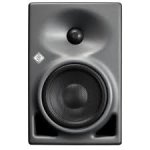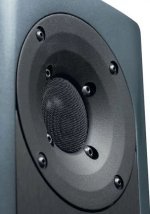Do you happen to know if there is an original source for that distance?
Maybe this?
https://en.wikipedia.org/wiki/Precedence_effect
0.2m seems too small a distance to be explained by the Precedence effect. 0.2m --> 0.57 msec. The Precedence effect is for sounds that arrive after at least a couple of msec, e.g. 2-4msec, according to your Wikipedia link. IMHO this time should be 4 to 6 msec or more. Less than that is still fused with the initial (direct) sound.
... that's why it's indistingishable from original sound and messes up. If i understand it correctly
Easier? I dunno about that. I've been rebating drivers in projects for 40+ years now and I could be done with the front panel in way less time than cutting two baffles/circles and gluing.Lot easier and if you botch a cut you don't loose the entire baffle.
Rob 🙂
The premise of this thread is a goofy one. After so many projects for so many decades, it would never even occur to me 'not' to rebate the drivers.
It''s obviously an aesthetically better way to go, and certainly no negative acoustic aspects.
Dave.
Driver recessing - how important? And does it cause people to avoid DIY?
I'll take a stab at the thread title.
1) How important? Ranks well below 42.
2) Does it cause people to avoid DIY? No. Some people - me - prefer the appearance of surface mounted drivers; feature not a bug. Other people - not me - who prefer the look of flush mounted will learn to use tools/methods to flush mount. Do I care if driver recessing turns people off to DIY? Doesn't make me want to set off on a crusade with a pair of coconut shells.
Separate questions that came up in the thread discussion:
1a) Non-recessed woofer mounting? I agree with everyone who said it depends. Therefore, the solution is to choose designs that work best with your preferred mounting method - i.e. when mounting method starts ranking above 42 for you. As an example, Neumann used a design where surface mounting a woofer below a tweeter created an advantage. They spread out diffraction in space and time in addition to improving directivity matching between tweeter and woofer at crossover. There is probably an additional advantage with the vent interaction that is over my head.

1b) Surface mounting tweeters? Still depends. One might work from a premise that surface mounting causes diffraction and is therefore universally bad. However, it depends on how you handle the diffraction. As an example, Kii's system leaned into tweeter diffraction by using the Seas DXT. Rightness or wrongness of tweeter diffraction depends on implementation. If you want to surface mount a tweeter choose a design where it doesn't hurt.

OTOH, people with more experience and knowledge than me disagree.
I'll take a stab at the thread title.
1) How important? Ranks well below 42.
2) Does it cause people to avoid DIY? No. Some people - me - prefer the appearance of surface mounted drivers; feature not a bug. Other people - not me - who prefer the look of flush mounted will learn to use tools/methods to flush mount. Do I care if driver recessing turns people off to DIY? Doesn't make me want to set off on a crusade with a pair of coconut shells.
Separate questions that came up in the thread discussion:
1a) Non-recessed woofer mounting? I agree with everyone who said it depends. Therefore, the solution is to choose designs that work best with your preferred mounting method - i.e. when mounting method starts ranking above 42 for you. As an example, Neumann used a design where surface mounting a woofer below a tweeter created an advantage. They spread out diffraction in space and time in addition to improving directivity matching between tweeter and woofer at crossover. There is probably an additional advantage with the vent interaction that is over my head.

1b) Surface mounting tweeters? Still depends. One might work from a premise that surface mounting causes diffraction and is therefore universally bad. However, it depends on how you handle the diffraction. As an example, Kii's system leaned into tweeter diffraction by using the Seas DXT. Rightness or wrongness of tweeter diffraction depends on implementation. If you want to surface mount a tweeter choose a design where it doesn't hurt.

OTOH, people with more experience and knowledge than me disagree.
Completely off topic, and stunningly politically incorrect as it it tobacco advertising, but...Lotus 72
What a fabulous livery / paintjob.
It does highlight that just one or two major sponsors avoids the car becoming the small ads section of the paper.
Black speakers with gold lining. Hmmmm...
Last edited by a moderator:
Is there a reason why the baffle at the tweeter can't be 3D printed to get that flush mounting and or whatever dish you need? One doesn't have to own a 3D printer to take advantage of that anymore
Good for you - you are practised and probably have a well-equiped shop. Not everyone does.Easier? I dunno about that. I've been rebating drivers in projects for 40+ years now and I could be done with the front panel in way less time than cutting two baffles/circles and gluing.
Nonsense. If you just need a through-hole behind the driver front piece, you can use a hole cutter or jigsaw - it doesn't have to be as accurate or as neat.The premise of this thread is a goofy one.
I agree that it looks nicer and has acoustic benefits. It just needs more equipment and skill.After so many projects for so many decades, it would never even occur to me 'not' to rebate the drivers.
It''s obviously an aesthetically better way to go, and certainly no negative acoustic aspects.
Dave.
Even barely that.It just needs more equipment and skill.
It can be done with either a trim router or plunge router.
Both can be bought for little money. (especially 2nd hand)
Next is just making a jig and you're done.
Routing itself is also very simple and easy.
It confuses me that there is even a discussion about this.
It confuses me that ignorant people can't write performant C++ code, its quite straightforward once you get the hang of it, and compures are cheap and compilers are free.It confuses me that there is even a discussion about this.
It made me chuckle a bit 🙂
Yes, I was going to write something about the same extent; routing is note "very simple and easy" if you do not practise and I must admit I have not been able to route a clean hole yet in my four attempts so far.
I am quite a competent C++ code writer though...
Yes, I was going to write something about the same extent; routing is note "very simple and easy" if you do not practise and I must admit I have not been able to route a clean hole yet in my four attempts so far.
I am quite a competent C++ code writer though...
Strange comparison, we are talking about speaker building, not abstract software programming.It confuses me that ignorant people can't write performant C++ code, its quite straightforward once you get the hang of it, and compures are cheap and compilers are free.
But I will bite for two reasons
1 - there are plenty of creative more simple alternatives that will give you the same or a similar result.
2 - if you want to get the most optimal results, there is just a certain basic skill level required. Otherwise you just have to just outsource it or something.
That counts for software programming as well.
That is just the reality of things.
What's the idea these days that practice and experience is an afterthought?if you do not practise
Obviously things need practice, but that doesn't make something difficult?
What I have seen people doing these days is to 3d print template that can be just copied over with a copy bit.
If you don't have a 3d printer, you can order these for about 10-20 bucks or so?
As someone who can wield hand tools and power tools with the best, I don't mind admitting that what I thought of as fine handicraft is now a primitive means to an end by those who are too lazy to learn sims, CAD and modelling and actively declining the use of better tools like CNC and 3D printing. A better executed build will ALWAYS be finer craftsmanship, and there is no way I would advise anyone to buy and learn to use a router. Instead, the recommendation is either a small, cheap desktop CNC or printer or online place that doe that. It's like telling someone to go and learn to use the poorer tool
Juvenile commentary.It confuses me that ignorant people can't write performant C++ code, its quite straightforward once you get the hang of it, and compures are cheap and compilers are free.
Cutting a rebated baffle take no special skills or equipment. (And barely more time.)
Just a simple router with circle jig and maybe an extra 0.5" straight-cutting bit in addition to the normal 0.25" bit.
Dave.
Agreed.no special skills
However fast spinning and sharp power tools can be intimidating if not used regularly. It takes some time to get used to how they behave.
Routers also can be more dangerous than a computer programming language.
Edit: I have to admit that C++ sounds quite intimidating to me ...
The whole premise of this forum is to advocate and provide information for those who want to Do It Yourself. 🙂
If a person is intimidated by a simple power tool like a router, then maybe this isn't the forum for them.
I can't make heads or tails of the premise underlying the OP's comments here. Puzzling.
Dave.
If a person is intimidated by a simple power tool like a router, then maybe this isn't the forum for them.
I can't make heads or tails of the premise underlying the OP's comments here. Puzzling.
Dave.
I make the point that things that are easy and natural to me because I've been doing it for 35 years might not be to you, and vice versa. You can't accept that, but that's not my problem.Juvenile commentary.
Cutting a rebated baffle take no special skills or equipment. (And barely more time.)
Just a simple router with circle jig and maybe an extra 0.5" straight-cutting bit in addition to the normal 0.25" bit.
Dave.
- Home
- Loudspeakers
- Multi-Way
- Driver recessing - how important? And does it cause people to avoid DIY?